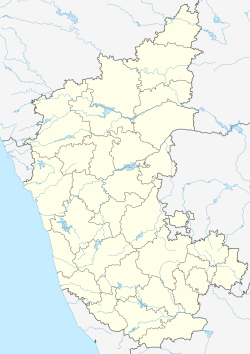Hampi
|
Hampi Hampe |
|
|---|---|
| Town | |

Virupaksha Temple, Hampi, Karnataka
|
|
| Nickname(s): Vijayanagar samrajjya | |
| Coordinates: 15°20′06″N 76°27′43″E / 15.335°N 76.462°ECoordinates: 15°20′06″N 76°27′43″E / 15.335°N 76.462°E | |
| Country |
|
| State |
|
| District | Bellary |
| Founded by | Harihara and Bukkaraya |
| Elevation | 467 m (1,532 ft) |
| Population (2011)Population of Hampi Village (across the river from Hampi City) | |
| • Total | 2,777 |
| Languages | |
| • Official | Kannada |
| Time zone | IST (UTC+5:30) |
| Nearest city | Hospet |
| Website | www |
| Group of Monuments at Hampi | |
|---|---|
| Name as inscribed on the World Heritage List | |
 |
|
| Location | India |
| Type | Cultural |
| Criteria | (i)(iii)(iv) |
| Reference | 241 |
| UNESCO region | Asia-Pacific |
| Inscription history | |
| Inscription | 1986 (10th Session) |
| Endangered | 1999–2006 |
Hampi (Hampe) is a village and temple town recognised as a UNESCO World Heritage Site, listed as the Group of Monuments at Hampi. in northern Karnataka, India. It was one of the richest and largest cities in the world during its prime. It is located within the ruins of the city of Vijayanagara, the former capital of the Vijayanagara Empire. Predating the city of Vijayanagara, Hampi continues to be an important religious centre, housing the Virupaksha Temple and several other monuments belonging to the old city. According to statistics of 2014, Hampi is the most searched historical place in Karnataka on Google. The empire boasted a massive army comprising close to two million men. In around 1500 AD Vijaynagar had about 500,000 inhabitants (supporting 0.1% of the global population during 1440-1540), making it the second largest city in the world after Beijing and almost thrice the size of Paris.
Hampi — traditionally known as Pampa-kshetra, Kishkindha-kshetra or Bhaskara-kshetra — is derived from Pampa, the old name of the Tungabhadra River (Pampa was Lord Brahma's daughter, who was later married to Lord Shiva) on whose southern banks the city is built. The name "Hampi" is an anglicized version of the Kannada name Hampe (derived from Pampa). Over the years, it has also been referred to as Vijayanagara and Virupakshapura (from Virupaksha, the patron deity of the Vijayanagara rulers).
Emperor Ashoka's Rock Edicts in Nittur & Udegolan (both in Bellary district) suggest that this region was part of the Maurya Empire during the 3rd century BC. A Brahmi inscription and a terracotta seal dating to the II century CE were also recovered from the excavation site.
The first settlements in Hampi date from 1 CE.
...
Wikipedia

